Mastering the Art of Fabric Painting
Fabric Painting transforms ordinary
textiles - like sarees, t-shirts and home fabrics - into unique and personalized works of art.
This practice has been around for centuries, with roots in ancient Indian, Chinese and Egyptian cultures. Traditional techniques like India's Kalamkari and Japan's Yuzen dyeing show how fabric
painting has long been a blend of creativity and craftsmanship.
Today, it's a popular choice for
fashion, home decor and DIY projects. With the rise of sustainable fashion and handmade aesthetics, fabric painting offers a creative way to personalise clothing and accessories. It's a skill that blends art with function, making every piece one of a kind.
Types of Fabric Painting Techniques
fabric painting is a great way to add personality to textiles. Whether you prefer freehand designs or structured patterns, here are some popular techniques to explore:
- Hand Painting - Hand Painting involves using brushes and fabric paints to create designs directly on fabric, offering complete creative freedom from detailed florals to abstract patterns. Best for - Custom clothing, home decor and accessories.
- Block Printing - Carved wooden blocks dipped in fabric paint create repetitive, symmetrical patterns. This centuries-old technique adds a handcrafted touch to textiles. Best for - Ethnic prints, scarves and home textiles.
- Screen Printing - A stencil and mesh screen help apply paint evenly, producing crisp and well-defined designs. It's widely used for mass production. Best for - T-shirts, tote bags and branding.
- Tie-Dye & Batik -
- Tie-Dye - Twisting, folding or tying fabric before dyeing creates bold, unpredictable patterns.
- Batik - Applying wax before dyeing results in intricate, multi-layered designs.
Best for - Boho fashion, beachwear and wall decor. - Stencil Painting - Pre-cut stencils help apply paint with precision, making it ideal for uniform and symmetrical designs. Best for - DIY fashion, upholstery and accessories.
- Spray Painting & Airbrushing - Using spray cans or airbrushes, artists create gradients and soft, misty effects for modern fabric art. Best for - Streetwear, galaxy prints and murals.
- Embossed Painting - Puff paints and thick acrylics create raised, textured designs that add depth and dimension. Best for - Kids' fashion, costumes and decorative items.

Hand Painting
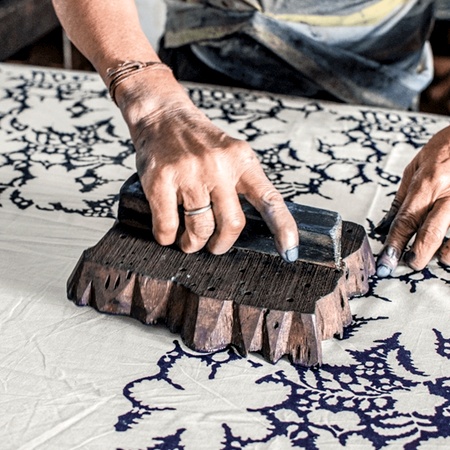
Block Printing

Screen Printing

Tie and Dye

Batik (Process of applying Wax)

Stencil Painting

Spray Painting
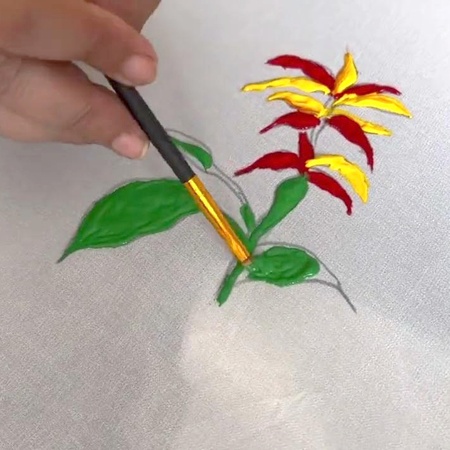
Embossed Painting
Best Fabrics for Fabric Painting
Choosing the right fabric is key to a great fabric painting project. Some fabrics absorb paint beautifully, while others need extra effort. Here's a look at the best options:
- Cotton - Cotton is ideal for fabric painting as it absorbs color well, maintains crisp designs and is compatible with all types of fabric paints. Pre-wash it to remove any chemicals that might affect the paint.
- Silk - Silk gives a rich, glossy finish, making colours pop. However, it requires special fabric paints to avoid stiffening. Stretching it on a frame helps keep the surface smooth while painting.
- Denim - Denim is thick and sturdy, perfect for statement designs. Since it doesn't absorb paint as fast as cotton, using a fabric medium helps prevent cracking and keeps the design flexible.
- Linen - Linen's natural texture makes painted designs stand out. It absorbs paint well but wrinkles easily. Ironing before painting ensures a smooth surface.
- Synthetic Blends - Synthetics don't absorb paint like natural fabrics, so using fabric-specific paints or heat-setting can help. Always test on a small patch first to see how the paint reacts.
Tools & Materials for Fabric Painting
Fabric painting is a fun and creative way to personalise textiles. To get started, you'll need the right tools and materials. Here's what you should have:
1. Fabric Paints
Different paints work for different effects:
| Paints | Effects |
|---|
| Acrylic Fabric Paints | Durable, vibrant and long-lasting. Ideal for most fabrics. |
| Water-Based Fabric Paints | Easy to use and blend. Great for beginners. |
| Oil-Based Fabric Paints | Rich colours but take longer to dry. |
| Fabric Markers & Pens | Perfect for fine details and lettering. |
2. Brushes & Sponges
Your tools affect the final look:
| Brushes & Sponge | Description |
|---|
| Flat Brushes | Cover large areas quickly. |
| Round Brushes | Best for outlines and details. |
| Fan Brushes | Create soft blending effects. |
| Sponges | Ideal for textures and background washes. |
3. Palettes, Stencils & Stamps
These help with precision and creativity:
| Tools | Details |
|---|
| Palettes | Mix and control paint consistency. |
| Stencils | Keep designs neat and consistent. |
| Stamps | Quick and easy patterns. |
4. Fixatives & Fabric Mediums
For durability and a professional finish:
| Medium | Description |
|---|
| Fabric Mediums | Mix with acrylics to keep fabric soft. |
| Heat-Setting Tools | Set the paint with an iron or heat press. |
| Fabric Sealers | Protect against fading and washing. |

Fabric Paints

Different Painting Brushes

Painting Stencils

Painting Stamps

Round Paint Sponge Form

Palettes for Painting

Fabric Medium

Fabric Color Fix
Step-by-Step Guide to Fabric Painting
Fabric painting is a fun and creative way to personalise clothes, home decor and accessories. Follow these steps for a smooth and lasting finish.
- Preparing the Fabric -
- Wash first - Removes dirt and chemicals for better paint adhesion.
- Iron it out - A smooth surface makes painting easier.
- Prime if needed - Light-coloured base coats help on dark fabrics.
- Sketch or Trace Your Design -
- Use chalk or a pencil for light outlines.
- Stencils or tracing paper work great for accuracy.
- Place cardboard under the fabric to prevent paint from bleeding through.
- Pick the Right Paint & Tools -
- Fabric Paint - Permanent, flexible and washable.
- Brushes & Sponges - Flat for broad strokes, fine for details.
- Fabric Markers - Ideal for outlines and intricate work.
- Palette & Water Cup - Keep colours mixed and brushes clean.
- Painting Techniques -
- Freehand - Great for organic designs.
- Stenciling - Ensures uniform patterns.
- Stamping - Use sponges or objects for texture.
- Blending - Mix colours for gradient effects.
- Dot Painting - Create intricate dot designs.
- Drying & Curing -
- Let it air dry completely.
- Follow recommended drying time (24 hours).
- Don't touch wet paint to avoid smudges.
- Seal for Long-Lasting Results -
- Iron on the reverse side for 3-5 minutes.
- Use a fabric sealant spray for extra protection.
- Wait 72 hours before washing and wash inside out.
Common Mistakes in Fabric Painting & How to Avoid Them
Fabric painting is exciting, but a few mistakes can ruin your hard work. Here's what to watch out and how to fix it...
- Using the Wrong Fabric - Not all fabrics hold paint well. Stretchy or synthetic fabrics can cause cracking or bleeding. So remember to stick to natural fabrics like cotton, linen or silk. If unsure, do a quick test on a small piece before starting.
- Choosing Low-Quality Paints - Cheap or regular acrylic paints fade, crack or peel after washing. Always go for high-quality fabric paints. If using acrylics, mix in a fabric medium for better adhesion and flexibility.
- Rushing the Drying Process - Touching wet paint leads to smudges and uneven texture. Let it dry for at least 24 hours before handling. Heat-set it with an iron (on the reverse side) for long-lasting results.
- Applying Too Much Paint - Thick layers make fabric stiff and prone to cracking. So apply thin, even coats, letting each layer dry before adding more. This keeps the fabric soft and the colours vibrant.
Fabric Painting in Fashion & Home Decor
Fabric painting is a creative way to personalise fabrics, making fashion and home decor unique and stylish. From custom clothing to upcycled pieces, it adds a personal touch that stands out.
- Home Decor - Give your home a custom touch with hand-painted cushions, curtains and tablecloths. Whether you prefer bold patterns or subtle designs, fabric painting allows you to match your decor to your personal style.
- Customising Clothes - Why buy mass-produced designs when you can create your own? Fabric painting lets you transform t-shirts, jeans, scarves and even shoes. Add florals, abstract patterns or personal monograms to make your outfits one of a kind.
- Upcycling Old Garments - Instead of throwing out old clothes, refresh them with new designs. A faded kurta can be revived with artistic patterns or a worn-out handbag can get a trendy update. It's a stylish and sustainable way to extend the life of your wardrobe.
- Unleash Your Creativity - Fabric painting is simple, personal and eco-friendly. Whether designing clothes, decorating your home or revamping old pieces, it's a fun and rewarding way to make fabrics truly yours.
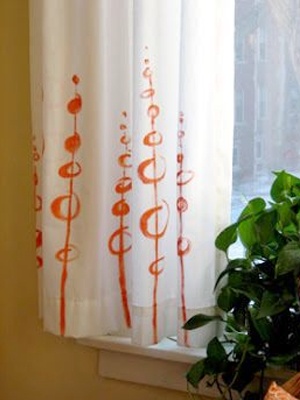
Fabric Painted Window Curtains

Canvas Shoes beautifully Painted

Block Painted Pillow Covers & Curtains

Hand Painted Floral Cushion Cover

Creative painting on Shoes

Hand Painted Door Curtains
How to Care for Painted Fabrics
Fabric painting adds personality to clothes, cushions and more-but if you don't take care of it properly, the colours can fade or crack. Here's how to keep your designs looking fresh.
- Wash with Care - Always turn the fabric inside out before washing. Hand wash with mild detergent for the best results. If using a machine, choose a gentle cycle with cold water. Avoid fabric softeners - they can break down the paint.
- Iron the Right Way - Never iron directly over the painted area. Turn the fabric inside out or place a thin cloth over the design. Use low to medium heat and avoid steam, as it can loosen the paint.
- Seal for Longevity - A fabric sealer or heat-setting the paint with an iron can help lock in the design. Check the paint label for the best sealing method.
- Store Properly - Fold and store your painted fabric in a cool, dry place away from sunlight. Avoid plastic covers - they trap moisture and can ruin the paint.
Advanced Fabric Painting Techniques
Fabric painting isn't just about adding colour - it's about creating something unique. If you're ready to go beyond the basics, these advanced techniques will add depth and dimension to your designs.
1. Metallic & Glitter Fabric Painting
Metallic and glitter fabric paints add a bold, eye-catching finish. They come in shimmer, pearl and holographic effects, perfect for outfits and accessories.
How to use- Apply thin, even layers with a sponge or fine brush.
- For extra vibrancy, paint over a white or light-coloured base.
- Let each layer dry before adding another for a rich finish.
Best For - Party outfits,
ethnic wear and abstract designs.
2. Shibori Painting Technique
A traditional Japanese tie-dye technique,
Shibori creates intricate patterns by folding, twisting or binding fabric before dyeing.
How to do it- Use natural fabrics like cotton or silk.
- Fold or twist the fabric and secure it with string.
- Dip in dye, let it set, then rinse to reveal organic patterns.
Best For - Scarves, tops,
sarees and home decor.
3. Marbling Effects
Marbling creates fluid, watercolour-like patterns by floating paint on water and transferring it to fabric.
How to do it- Fill a tray with water and add fabric paint.
- Swirl colours with a toothpick for patterns.
- Place the fabric on the surface to absorb the design.
- Lift and dry before setting the paint.
Best For - T-shirts, dresses, pillow covers and modern decor.
4. Layering & Texture Techniques
Adding layers and texture brings depth to fabric designs, making them look more dynamic.
How to achieve it- Use different brush sizes for highlights and shadows.
- Apply translucent paint layers for a blended effect.
- Experiment with sponges, stencils and puff paint.
Best For - Jackets, canvas bags and upholstery.
The Artistic Fusion of Outfits & Fabric Paints

Art on Every Step
A sleeveless white dress transformed into wearable art with bold, hand-painted floral bursts in
vibrant colors.

Painted Petals on Lilac
A dreamy lavender georgette saree adorned with hand-painted floral motifs. The soft, flowy fabric pairs elegance with vibrant artistry, perfect for a statement look.

Blue Feathered Elegance
A stunning navy blue
gown adorned with hand-painted white feather patterns. The flowing fabric and artistic craftsmanship make it perfect for evening events.

Pallu of Watercolor Wonders
A light blue saree reimagined with a pallu painted in vivid floral motifs. The flowing material and vibrant colors create a wearable masterpiece that balances elegance with creativity.
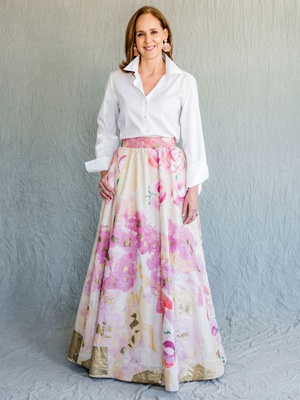
Hand-Painted Floral Elegance
A flowing skirt brought to life with hand-painted
floral patterns in soft pinks and creams, paired with a crisp white shirt.

Green Base with White Florals
A deep green saree adorned with hand-painted white floral designs. The rich fabric and delicate artistry create a stunning contrast, blending tradition with modern elegance.

Blossoming White Elegance
An elegant white sleeveless dress with bold floral patterns painted on the
skirt and bodice. The flowing fabric and artistic details transform art into wearable beauty.
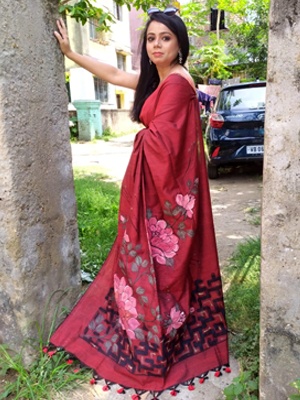
Vibrant Maroon Artistry
A maroon saree reimagined with hand-painted floral motifs and geometric designs. The luxurious fabric drapes gracefully, while the artistic details add a touch of uniqueness.

Art in Motion
A playful white dress with a vibrant, hand-painted skirt bursting with colorful floral and abstract patterns.

Floral Symphony in Sky Blue
This pale grey saree features a harmonious blend of hand-painted flowers in bold multi-colors, creating a lively canvas of art.

Sunny Yellow with White Blooms
A vibrant
yellow A-line dress featuring hand-painted white floral accents. The artistic A-line silhouette and short sleeves add playful charm.
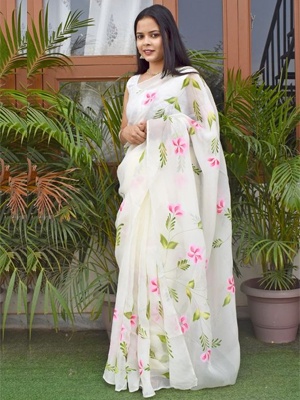
Whispers of Color in White
This white saree is adorned with delicate hand-painted flowers, creating a harmonious blend of tradition and modern art. The flowing fabric and vibrant hues make it an elegant choice.

Hand-Painted Rose Whispers
A
romantic pink dress adorned with hand-painted roses in vibrant red and green. The flowing layers make it stylish for casual outings.

Whispers of Art in White
A white Organza saree reimagined with hand-painted designs, adding a touch of artistic flair. The flowing material and vibrant details make it perfect for turning heads.

Nature's Palette in Organza
A vibrant green Organza saree painted with delicate floral designs. The lightweight fabric flows gracefully, merging nature's beauty with artistic expression

Blue & Gold Artistry on White
An elegant white skirt hand-painted with delicate blue and gold floral patterns, paired with a soft blue top.
Fabric painting is more than just a
craft - it's a way to express yourself. It lets you turn plain fabrics into something personal and unique. Whether you're customising clothes, adding a personal touch to home decor or just experimenting, every brushstroke brings your ideas to life.
The best part is that there are no rules. Mistakes can turn into unexpected designs and every piece you create is one of a kind. So, grab your paints, mix your colours and start creating. Your imagination is the only limit...!




















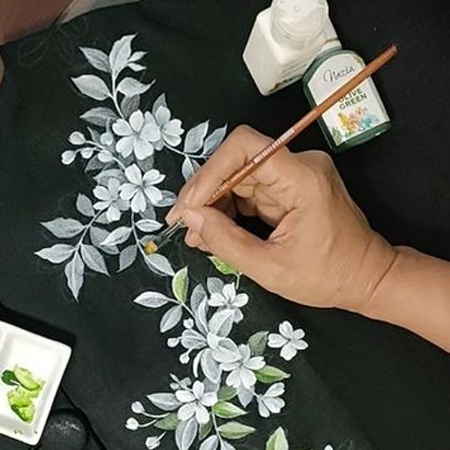








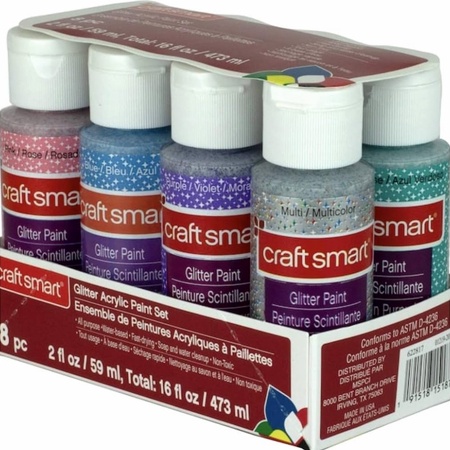



















 CONTACT USWaves Institute of Fashion Designing,
CONTACT USWaves Institute of Fashion Designing,